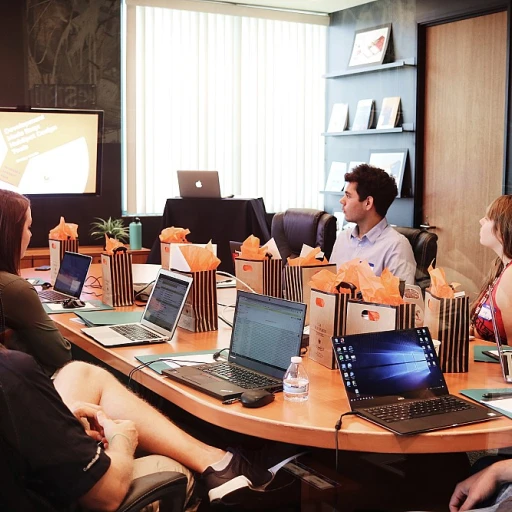
Understanding the Role of Video in Team Communication
Video's Transformative Power in Team Communication
In today's dynamic corporate landscape, utilizing video as a medium for communication unlocks immense potential for fostering engagement among team members. At its core, video content not only simplifies complex ideas but also enhances understanding and cohesion within a team, irrespective of physical location. The visual and auditory elements combine to create an immersive experience that written communication alone often lacks. Video is especially beneficial in promoting a strong sense of company culture. Through well-crafted corporate videos, employees can connect with the brand, grasp shared values, and better integrate into the corporate ethos. Moreover, as the use of digital platforms proliferates, sharing video content on a company's youtube channel or through social media can effectively reinforce key messages and initiatives. As companies continually strive to foster inclusivity and collaboration, videos help bridge communication gaps between remote and on-site employees. This integration is crucial in ensuring that every team member feels valued and included in the company's growth trajectory. Platforms like YouTube facilitate easy access and flexibility, enabling team members to engage with content at their convenience. To explore more on crafting communication strategies that resonate well with frontline employees, consider visiting effective HR communication strategies with frontline employees. This resource provides valuable insights on maximizing the benefits of video in internal communication efforts. Ultimately, leveraging video for team interaction not only strengthens internal communication but also aids in creating a cohesive and dynamic company environment where ideas can flourish and every voice can be heard.Types of Videos to Foster Team Engagement
Exploring Various Video Formats for Team Interaction
Incorporating videos in your company culture goes beyond traditional presentations. There are a multitude of video types that can make team communication more engaging and effective. These videos can connect with employees, cultivate a stronger brand image, and foster team engagement.
- Introduction Videos: Ideal for welcoming new team members, these videos can introduce the team, share company values, and provide a glimpse into the product or service offerings. Such content humanizes the corporate environment by putting faces to names.
- Team Building Videos: Emphasize collaboration through activities captured on video to promote team bonding. These can be shared on social media or within internal platforms to reinforce corporate culture.
- Success Stories: Share successful project outcomes in engaging formats to motivate and inspire. Highlighting employee achievements serves as strong marketing material for potential clients and showcases the company's capabilities.
- Product Demos and Tutorials: Creating informative videos about products or services aids in clarifying complex ideas, providing training to employees, and showcasing to potential clients.
- Behind-the-Scenes Content: Provide the audience with a look at the company’s day-to-day operations. These videos help in building transparency and trust, offering an authentic view of the team dynamics.
Leveraging effective communication strategies aids in selecting the most impactful video format for your audience. By identifying the right content type, you not only entertain but also meet the informational needs of your employees and stakeholders.
Understanding your audience's preferences and the context of each video are key considerations in crafting effective communication. By sharing diverse types of video content, you facilitate a richer, more engaging communication experience within your team.
Creating Personalized Video Messages
Crafting Tailored Video Messages for a Personal Connect
Creating personalized video messages is an innovative way to reach out to employees and team members, enhancing the corporate culture. These bespoke videos allow a company to share specific ideas or updates, addressing an audience directly which helps to foster a sense of being valued and understood within the organization. In the realm of team communication, personalized videos can significantly improve engagement by allowing team leaders and managers to address employees with tailored content. These messages could range from congratulating a team member on achieving a milestone to recognizing a team's collective efforts in a project. Videos help break away from traditional, text-heavy communication methods, providing a more dynamic and engaging way to support team building. Companies can integrate personalized videos into various aspects of corporate communication. For instance:- Introduction of New Team Members or Leadership: Share these videos across the company’s social media or internal platforms, so employees can virtually meet the newest additions to their team and learn about their roles and backgrounds.
- Share Ideas and Insights: Personalized videos from leadership can communicate new strategies, ideas, or goals more effectively, ensuring all team members are aligned with the company's vision.
- Product and Service Updates: These videos can be crafted to inform team members about new product launches or updates, tuning them into what potential clients might be expecting.
Leveraging Video for Training and Development
Utilizing Videos as a Tool for Training and Development
Videos have become a vital tool for training and development within companies, effectively enhancing both the skill set of employees and the overall corporate culture. Producing educational and informative team videos allows organizations to share key knowledge and ideas with their team members in a clear and engaging manner. For effective training, corporate videos can be designed to not only introduce a product or service but also to incorporate role-playing scenarios that reflect real challenges employees may face. By doing so, employees are better prepared to meet actual demands with confidence. This type of video content encourages a deeper understanding through visualization, which often surpasses traditional training methods in retaining information. Additionally, leveraging platforms like a company’s YouTube channel can extend the reach of these training materials. Accessible video content on such platforms ensures that team members, both local and remote, can revisit the material as part of continuous learning. Utilizing a library of training videos helps employees adapt quickly to changes and better align with the company's goals. Videos are not just a tool for developing hard skills. They can also help nurture soft skills, enhancing communication, decision-making, and team-building dynamics. Engaging, relatable video production that mirrors the company culture positions employees to better identify with brand values, thus fostering stronger team engagement. Video content not only supports traditional training programs but also facilitates innovative methods such as e-learning modules, webinars, and self-paced learning videos. A vast variety of video ideas ensures that there are numerous options for creating impactful training experiences, meeting different learning styles, and addressing diverse audience needs. In summary, integrating team videos into training and development practices contributes to smoother onboarding processes, promotes continuous professional growth, and aligns the team with the company’s strategic goals. It’s more than just about disseminating information—videos help create an interactive and immersive learning environment that resonates with employees, ultimately enhancing overall team performance.Best Practices for Producing Effective Team Videos
Producing Successful Corporate Team Videos
Creating engaging and effective team videos requires a blend of creativity, technical skills, and a solid understanding of your organization’s goals. Here are some best practices to consider:- Understand Your Audience: Just like any form of communication, knowing your audience is crucial. Tailor your video content to the specific interests and needs of your employees, whether it's a corporate video for internal communication or a team video for social media marketing. Understanding your audience helps resonate your message effectively.
- Define Clear Objectives: Before you even start filming, clearly define what you want to achieve with your video. Whether it's to introduce team members, enhance company culture, or share new company policies, having a clear objective will guide the content and style of your video.
- Keep it Concise: Time is valuable. Respect your audience’s time by keeping your corporate videos straight to the point. Concise videos are more likely to maintain engagement and effectively convey your message.
- Incorporate Branding Elements: Make sure to weave in your company’s brand identity within your videos. Consistent use of colors, logos, and taglines strengthens your brand and makes your video appear more professional.
- Utilize High-Quality Production: Regardless of your budget, aim for the highest possible production quality within your means. Poor audio-visual quality can distract from your message and reduce engagement.
- Encourage Employee Participation: Including your team members in the video production process not only creates more relatable and authentic content but also helps in fostering a sense of community and ownership among employees.
- Assess and Adapt: After releasing your videos, gather feedback and analyze their impact. Use insights to optimize future video production, ensuring alignment with your communication goals.
Measuring the Impact of Video Communication
Evaluating Video Communication Success in the Workplace
To ensure that video communication efforts are successful within your company, measuring their impact is essential. Whether you are sharing company updates, meeting team members, or introducing new product services, it is crucial to track the effectiveness of your video content to foster a vibrant company culture and bolster team collaboration.- Engagement Metrics: Start by examining the engagement metrics of your videos. Consider the number of views, shares, like ratios, and comments on social media platforms and internal channels. These insights can help identify which type of content resonates most with your employees and audience.
- Feedback Gathering: Soliciting feedback from team members on how videos have helped them understand a product or meet team goals is invaluable. This feedback can further be used to share ideas on improvements and cultivate a culture of open communication.
- Knowledge Assessments: After conducting training sessions or instructional corporate videos, utilize quizzes or follow-up surveys to assess knowledge retention and comprehension among employees. This will help you gauge the educational effectiveness of your video content.
- Project Management Tools: Integrate project management tools to track video production processes. This can provide insights into how efficiently videos are developed and released, helping improve your corporate video strategy.
- Performance Analysis: Monitor your company’s key performance indicators (KPIs) to determine whether video communication is contributing to overall business goals. Consider metrics such as increased productivity, reduced error rates, and heightened employee engagement as signs of success.












